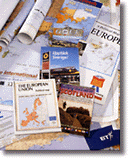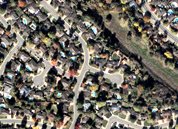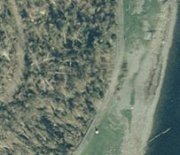Letters, Points of Interest, Week in Review (Announcements, Contracts, Products, Events, Hires) Back Issues, Advertise, Contact, Subscribe/Unsubscribe If, for some reason you cannot read this document, visit: http://www.gismonitor.com/news/newsletter/archive/123003.php
Editor's Note Happy new year to all. Adena

For the holidays he compiled a "naughty and nice" list (registration required) of consumer technology vendors. Some of his notes apply to situations in our industry. 1) Naughty: Pogue blasts the "hard, clear, vacuum-formed plastic" containers in which vendors deliver software and various small hardware products. These are impossible to open. While fighting to open a software product (from a vendor which hoped I'd review it), I actually cut myself on said packaging. 2) Nice: He honors "Circuit City and its no-hassle return policy. You don't even need your receipt." Why? It's in the computer. Wouldn't it be nice to call GIS tech support and not need your customer ID? Perhaps we are already there? Readers? 3) Nice: Pogue points out that Steve Jobs of Apple, "solely on the force of personality" convinced record companies to help him build an inexpensive, legal music-downloading service. Where's our comparable leader for NSDI/GSDI? Who will fund the important work? 4) Nice: He holds up PC World, "a magazine that's unafraid to bite the hand that feeds it, month after month." The publication regularly rates its advertisers low in the ratings if they deserve it. Another bonus: a monthly feature noting bugs in Microsoft Windows products. By the way, PC World covers GPS receivers in its December issue. I'm pleased to note that I've seen more writers, editors, and publishers go out on limbs in GIS publications in the last year. That's just what an independent press is supposed to do. 5) Nice: Pogue describes the initiative from Microsoft, AOL, and Yahoo, "with no immediately apparent profit motive" to collaborate on the spam problem. Perhaps I've not given enough credit to MapInfo, Autodesk, Intergraph, and Laser-Scan for taking on a smaller, but clearly important interoperability issue, in our space. I won't suggest there is no profit motive in this case, but then, none of these companies are the Microsoft of geotechnologies. 6) Naughty: Hewlett-Packard, Philips and Sony, introduced "an utterly superfluous recordable DVD format called DVD+RW" that's incompatible with the format that the 230-member DVD Forum approved. I can think of a few formats that might be considered superfluous in geospatial space.

Extreme Mapping and Extreme Marketing The bulk of the paper suggests that the essential qualities for extreme sports - speed, precision, freedom, control, and expression - are also shared by mapping. The paper goes on to suggest that both mapping and the people who perform it need to have, or should aspire to have, these qualities. For the record, I think many of us who participate in "non-extreme" sports and other vocations seek to develop those same qualities. The paper however has at least one other motive. Not once, but twice, author Carey Mann suggests we join Bentley in using the term "geospatial" instead of GIS or other related words. He even quotes Directions Magazine editor Joe Francica noting that "The term GIS is gone" in the context of a discussion of Oracle's 10g. Recall that, some years ago, Bentley coined "geoengineering" for its flavor of GIS. Now, Bentley hopes to claim, or perhaps reclaim, the term "mapping."

Letters "If they build that tunnel for $39 million, then they obviously are not using the Big Dig [our big, over budget highway project in Boston] contractors!" Robert Burke also wrote noting, "The Chunnel cost more than $13 billion." I had it wrong. The $30 million dollar figure I quoted was for the initial study. (I think Doyle may have transposed the 39 kilometer length with my incorrect $30 million cost.) � John Pound found another error in last week's Points of Interest. "Oops - I think the paragraph on National Geographic maps should have read Evergreen, Colorado, not Oregon." That's quite correct. I can't say what I was thinking. He went on to say some nice things: "But that's just to give me an excuse for saying Thank You for the most concise and useful overview of Oracle's role in things that I've ever yet read. (And a lot of other interesting things in this issue, as in most.)" � Before Friday had ended I had five e-mails noting that I'd misused "tombs" for "tomes" in referring to the books from ESRI Press. Four of those were from current or former ESRI employees. Thanks for your sharp eyes! My apologies to all. In particular, I want to apologize to Christian Harder, and the rest of the crew at ESRI Press. I was indeed trying to honor them. � And, there was more mail from ESRI, this time from Marcy LaViollette, who works with ArcWeb Services. "In the Dec 18th edition of GIS Monitor the first item on your Top Ten of 2003 commented on the various GIS Web services available including: "'ESRI in its ArcWeb Services for ArcGIS, to Microsoft Research's TerraServer USA which supports SOAP and .NET...'" "Although you didn't explicitly say that ArcWeb Services do not support SOAP, it was implied by your phrasing. I want to make sure that you and your readers understand that ArcWeb Services is a family of products that includes ArcWeb for Developers, our SOAP based product that supports virtually every programming language including .NET, Java, Cold Fusion MX, PHP, and Perl to name a few. I strongly support your top pick for 2003!" � Earlier in December, in my review of Autodesk University, I noted that I couldn't get my head around how the Infrastructure Solutions Division's various efforts tied together. I wrote: "My sense from this talk is that ISD is trying to be all things to all people. How does enhancing revenue from design/construction/operation, tie into emergency response and 3D civil engineering models? It's a bit of a stretch for me at this time." Brad Sharp, Sr. Manager, Government Solutions and Dave Simeone, Senior Product Manager, Civil Solutions both in the Infrastructure Solutions Division wrote to straighten me out. You can find their letter online.

Points of Interest Future News. Multimap.com signed an agreement with sports retailer JJB Sports, which will allow users of the JJB site to search for their nearest store and view a map of the surrounding area in 10 different scales. This will be announced January 1, 2004. GIS Software Sabotage. Sify, an Indian news service reports on piracy, along with a story about shady dealings with GIS programming. The story goes that a European Union client made a contract with an Indian company to build GIS software. After the nine programmers were close to completion, they demanded a salary increase. Management refused and asked for their resignations. In retaliation, the programmers destroyed the existing code. The company involved didn't press the issue, fearing it would receive no further contracts. Arctic Vegetation Map...After All These Years. Pulling together mapping data from many sources is not easy. Pulling together vegetation data for the Arctic fits into that category. The Associated Press describes the sources as "a scattered puzzle of varying scales, legends, languages, and coverage areas." Begun in 1992, the " UAV Helicopter. Yahama makes flutes and drums and...Unmanned Aerial Vehicles (UAVs). The Japanese government incentivized the company into this new arena, with significant success. The Yamaha RMAX helicopter is the most advanced commercially available UAV in the world right now. The Aerial Photography version can fly up to 100 meters above the ground and costs between US$150,000 and US$230,000. One of the big advantages? The helicopter is easy to operate cutting down on expensive training. Another: it can stay still with an "almost complete lack of vibration" making it suitable to capture repeat photos in exactly the same location. Tracking Workers' Vehicles on the Job. The recent discussion of Massachusetts snow plow contractors concerns over required GPS tracking after the first of the year turned one writer at the Christian Science Monitor onto the topic. (That paper is based in Boston and did indeed inspire the name of this publication.) It's much the same story, with these tidbits tossed in: "By 2006, according to some estimates, 4 out of 5 new vehicles will come equipped with the [GPS] technology." "UPS workers in the Teamsters union negotiated last year to make sure GPS data wouldn't be used in evaluations." Companies that sell the technology argue that GPS, just like other technologies that entered the workforce like cell phones and pagers at first seemed like a ball and chain, but now workers can't imagine being without them. One tracked street sweeper puts it this way, "As far as Big Brother looking over you, of course it smacks of that," he says. "But if you're doing your job, you don't worry about that." Hacking OnStar. The New York Times reports that more and more people are ripping out their car's built-in OnStar GPS receivers and linking them up to laptops for in-car use. OnStar charges monthly fees whereas a good GPS-enabled mapping program can run under $30. On the other hand a decent GPS is fairly cheap, too. So, why bother rewiring the system, which typically lies behind the glove box? Basically, "because it's there." New Driving Laws in California Exempt GPS Displays. According to the California Highway Patrol there is a long list of new laws for drivers come January 1, 2004. One among them relates to the location of video screens in vehicles. A new law "prohibits driving a vehicle while a television broadcast or video display is operating if the screen is forward of the driver's seat." The bill exempts GPS displays. What Men Want. A poll of 1,457 Swedes, in companies with ten or more employees, revealed that men and women both have the same top pick for cell phone enhancements. Both men and woman want to be able to use the same phone for cell and wired calls. After the number one pick, the sexes diverge. Women want a security alarm and men want "a satellite navigator with maps." I guess Swedish men don't like to ask for directions either. Digital Angel Jumps in Cattle Tracking Opportunity. Christmas was barely over, but two executives from Digital Angel had already begun marketing their solution to cattle/meat tracking as concerns about mad cow disease grow in the United States. The two executives provided an interview to CEOCast last week. (CEOCast is an investor relations firm, not a media outlet.) Digital Angel uses RFID implantable microchips, e.Tags, to track an animal's origins, location, and status. The company actually began 60 years ago in the cattle tracking business. I heard on the radio that the USDA had a website prepared for when mad cow disease hit the US and simply put it online this past week when the first case was confirmed. I suspect the marketing people at Digital Angel were similarly prepared. This week the company released a statement in response to all the enquiries. Share prices in the company have doubled since the first suspected case of the disease in the U.S. was announced. Dual Place Names and Emergency Services. New South Wales, Australia is in the midst of a project to add Aboriginal place names to existing English names of landmarks in Sydney. Under the Geographical Names Board's policy, only features such as rivers, islands, and points can be given dual names but not streets, suburbs, or towns. The reason? It could cause confusion for emergency responders. While there are challenges to getting the new names approved, said one participant, "When people once again utter the words that have been the names of our places for eons upon eons the sweet voice of our land will once again speak with meaning to her children." Uncle Roy Is All Around You. I guess I missed this location-based game during its debut this summer in London. Funded by Microsoft and several universities the game sent players, armed with PDAs into the city to find the elusive "Uncle Roy." Those playing on the Internet could track players and help or sabotage the "live" players. The game used a mix of hired actors and red herrings to make the event interesting. Players "reported a strong emotional involvement with the game." While I'm sure that's true, how much of that was enhanced by the LBS aspect of it? I recall my one experience with a game that integrated life and a quest. In my college house, each "Assassin" was tasked with "killing" a dorm-mate with a water gun. I was paranoid for a week! LBS for Guns. Sandia National Lab undertook a study in 1996 to explore technologies to safeguard guns. One option explored, listed among the "less technologically advanced systems" in an article from Gannett News Service involves the ability to disable a gun once it enters/exits a specific geography. The concept relies on GPS to locate the gun. One big concern of gun owners is that guns could be disabled without their permission. Moreover, though not mentioned in the article, apparently it is fairly easy to "fake out" a GPS receiver to make it think it's at some location other than its actual one. Tracking Kids: Legal Issues. An article at Wireless Business & Technology by a real live lawyer basically confirms that children in the U.S. have very few rights and that parents have many. That means that in essence there are no laws limiting parental tracking of children via GPS or other technologies. One interesting highlight: there are instances where parents have limited say in where children go. Courts typically uphold child curfew laws, even over parental objections.

Week in Review
Lovell Johns USA, a division of Lovell Johns Limited, announced that it has launched US operations. The company provides GIS-based digital map and publishing solutions to a variety of industries. ESRI recently provided teacher training to Iraqi nationals from the Ministries of Planning, Mines, Housing and Construction, and Water Resources in support of the country's redevelopment efforts. The company also donated software. The company has joined forces with Career Corner TV, Corp to promote opportunities in the high-tech geospatial industry for students in the United States and around the globe.
Aerials Express LLC announced the availability of more than 8,000 square miles of seamless aerial imagery on DVD or CD for Central Arizona including metropolitan Phoenix and surrounding communities. The new coverage is ortho-rectified at a resolution of 2 feet per pixel.
Kentucky was awarded a $1 million federal grant to establish an electronic system of underground maps for locating abandoned coalmines. Pennsylvania also received $1 million. The grants were among $3.9 million in awards to 13 states made by the Mine Safety and Health Administration. I think since federal money is being used, the data should be made part of the NSDI.
Orbital Imaging Corporation (ORBIMAGE) announced the official release of its first set of sample images from its OrbView-3 high-resolution commercial imaging satellite. The images at one-meter resolution in OrbView-3's panchromatic imaging mode (black and white), and at four-meter resolution in the multi-spectral (color) are examples of the OrbViewBASIC product line. An ortho product line is expected, too. The satellite launched in June. Matthew O'Connell, ORBIMAGE's Chief Executive Officer noted, "we could have released engineering samples of our imagery months ago with promises of better quality to come, but we decided to finish validation and calibration first." At right, a simulated OrbView-3 one-meter colorized image of Sacramento, California. � Contracts and Sales Richland County, South Carolina selected JumpStart GIS, Inc. for a 136,000+ parcel conversion project. During the two-year project the company will develop a custom cadastral geodatabase model that integrates with the county's enterprise GIS.
To assess the impact of Hurricane Juan, the Nova Scotia Department of Natural Resources recently commissioned James W. Sewall Company to acquire aerial photography of 1.5 million acres of forested land and to develop digital orthophotography for use as a damage analysis tool. A category 2 hurricane, Juan made landfall on the coast of Nova Scotia September 29, downing trees, damaging homes, and causing power outages as it tracked northward to Prince Edward Island. To survey the damage, Sewall flew on either side of the storm track, acquiring 1000 true color aerial photographs at 1"=2000'. � Products MapTech announced that starting in 2004 Digital ChartKit users gain free access to Maptech's exclusive Internet updating service for newly released NOAA Chart Editions for the entire calendar year. MapText, Inc. released version 4.0 of its flagship product Label-EZ for all the popular GIS systems. The new version offers a friendlier, easier-to-use graphical interface and contains numerous enhancements and new capabilities. MWH Soft, Inc., a provider of water resources applications software, announced the worldwide release of InfoSewer for ArcGIS. ACRES has released a new remote sensing product on DVD. ACRES Landsat 7 Mosaic of Australia is an inexpensive satellite image of Australia ($AU99) using recent imagery (1999-2000). Miner & Miner was the first GIS vendor to pass compliance testing for MultiSpeak2. ArcFM and Network Adapter were tested and certified compliant against the MultiSpeak2 schema on December 16, 2003. MultiSpeak2 gives utility companies the ability to interface ArcFM to other MultiSpeak compliant applications, including engineering analysis, outage analysis, and SCADA functions. ESRI released a new version of BusinessMAP Travel Edition, an affordable, easy-to-use routing and database mapping solution for business travelers. GeoConcept SA announced the availability of GeoConcept Pocket 2.0, a new mobile application solution. GeoConcept Pocket 2.0 provides detailed images that can be modified and enriched to meet user requirements at any level. It allows the user to synchronize easily and in real-time with the central workstation and applications including databases. � Events � Hires and New Offices
GIS Monitor Back Issues
Advertise With Us
Contact
Subscribe/Unsubscribe |



